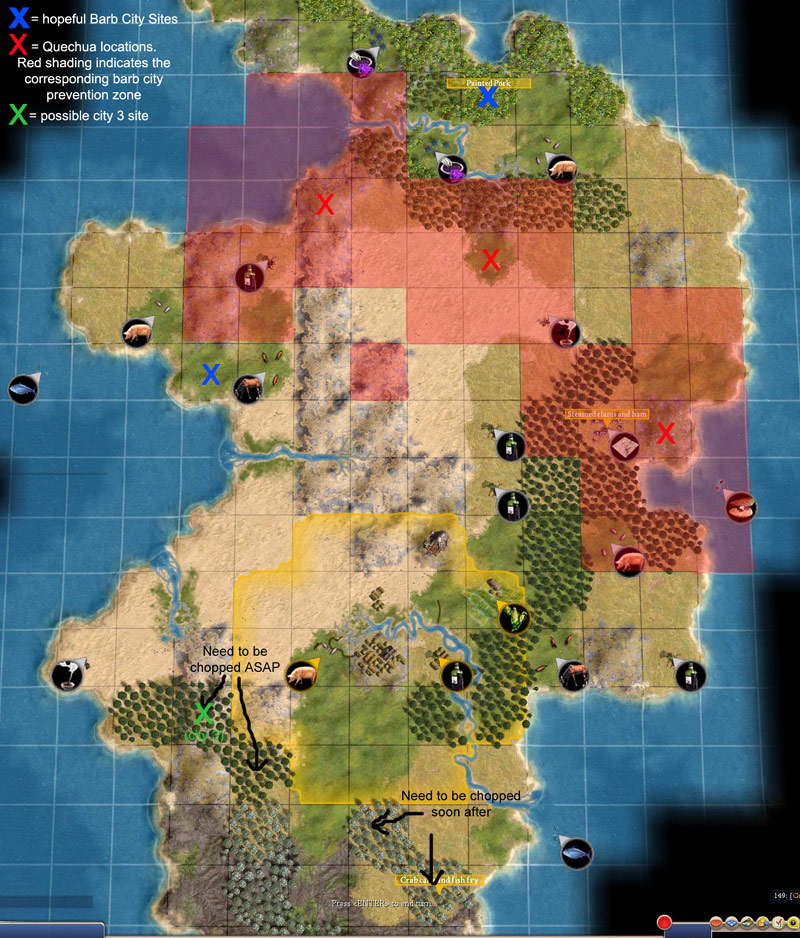Nice turns, Bede!
A few thoughts on the future and an accompanying map:
I did a little test with our Quechua to make sure they can take out a barb-archer city, and it went very well. Four Quechua promoted with Cover have an excellent chance of destroying three barb archers. Even better, in one of my two test scenarios, two of the archers came out of the city and attacked
me while I was fortified on a forest/hill, which left only one archer to kill.

I think we should try to exploit this opportunity.
If we post quechua on the three red x’s on the map, we might be able to get the barbs to found cities in the exact locations we want them to (the blue x’s), and prevent them from founding a city where we don’t want it (like hill tops which our quechua could not capture). The barbs tend to choose sites that claim three or more special resources before founding in other areas. The red shading on the map shows where our quechua would prevent a city from appearing.
Two of those locations are not very defensible, of course, and I am sure our quechua would occasionally have to duck into forest for defense and healing, then return. I think it is worth trying to stay in those general areas though, and to be sure that the blue x’s (the prime barb city sites), stay under the fog as much as possible.
There are several other hills that would make good quechua locations after these three, but I didn’t mark them because I think these are the most important. The plain hill north of the marble site, for example, should definitely have a sentry too if we have a quechua available.
I am now leaning toward founding our third city on the green x. This site has several advantages:
1) The city can be founded sooner than the dye site to the north (which we might get barbs to found for us anyway)
2) In around 5 turns we will have writing, which means we can start running scientists for an academy in the capitol after a few settlers are built. During that time the capitol will not be able to work both the pig and the corn, so city 3 could take advantage of that free pig to grow quickly.
3) Since we are founding on a plain hill and have another plain hill and two desert hills to work, the city will be a good hammer producer. We could use that to build a barracks and promoted quechua so that we can take a barb city if it appears.
4) When the city is able to grow beyond 5, it will be able to develop villages that can later be handed over to the capitol. It will also make a good settler/worker producer in the meantime thanks to the pig and the FPs.
If this site does become the location of our third city, the forests marked on the map should be chopped into settler production in the capitol ASAP. Otherwise we would lose one of them and the shields for the other would go to city 3. The forest at the “Crab cake and Fish Fry” location and the one NW of it should be chopped next.
Bede said:
As for the victory conditions the military ones holds the most interest for me as the management of overseas invasions is always a real challenge. And I think it will take long enough that we can enjoy all the toys as well....
Well, that would depend on what you mean by toys.

If you mean Grenadiers, catapults, galleys, barracks and courthouses, then yes we will certainly have lots of them. But if we go for the early domination that Gator and Leif last mentioned, we probably won't need any of the buildings that come after the classical age, except perhaps the Hagia Sophia or Versailles wonders. If we catch an AI with its pants down (archer defense), then I doubt we will even build theatres. We will also probably only use the bureaucracy, caste system and theocracy civics, although there is a small chance we may use vassalage near the end of the game.
On Monarch level, we really don't need many techs to conquer the world and support our economy, and building markets, theatres and things like that just delay the victory. All we need is a military tech advantage over the AI and lots of miltary units and workers.
Edit: I think that chopping is a priority over roading to the marble, at least for the present.







 I think we should try to exploit this opportunity.
I think we should try to exploit this opportunity. If you mean Grenadiers, catapults, galleys, barracks and courthouses, then yes we will certainly have lots of them. But if we go for the early domination that Gator and Leif last mentioned, we probably won't need any of the buildings that come after the classical age, except perhaps the Hagia Sophia or Versailles wonders. If we catch an AI with its pants down (archer defense), then I doubt we will even build theatres. We will also probably only use the bureaucracy, caste system and theocracy civics, although there is a small chance we may use vassalage near the end of the game.
If you mean Grenadiers, catapults, galleys, barracks and courthouses, then yes we will certainly have lots of them. But if we go for the early domination that Gator and Leif last mentioned, we probably won't need any of the buildings that come after the classical age, except perhaps the Hagia Sophia or Versailles wonders. If we catch an AI with its pants down (archer defense), then I doubt we will even build theatres. We will also probably only use the bureaucracy, caste system and theocracy civics, although there is a small chance we may use vassalage near the end of the game. 


